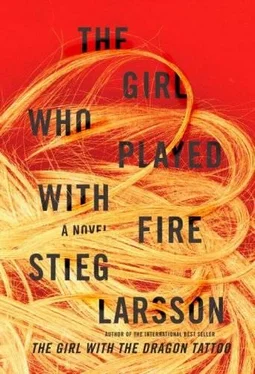Ekström, on the other hand, moved with ease, adjusted his glasses, and adopted a suitably serious expression. He let the photographers take their pictures before he raised his hands and asked for quiet.
“I’d like to welcome you all to this somewhat hastily arranged press conference regarding the murders in Enskede late last night. We have some more information to share with you. My name is Prosecutor Richard Ekström, and this is Criminal Inspector Jan Bublanski of the County Criminal Police Violent Crimes Division, who is leading the investigation. I have a statement to read, and then there will be an opportunity for you to ask questions.”
Ekström looked at the assembled journalists. The murders in Enskede were big news, and getting bigger. He was pleased to note that Aktuellt, Rapport , and TV4 were all there, and he recognized reporters from the TT wire service and the evening and morning papers. There were also quite a few reporters he did not recognize.
“As you know, two people were murdered in Enskede last night. A weapon was found at the crime scene, a Colt.45 Magnum. Today the National Forensics Laboratory established that this gun was the murder weapon. The owner of the weapon was identified, and we went looking for him today.”
Ekström paused for effect.
“At 4:15 this afternoon the owner of the weapon was found dead in his apartment in the vicinity of Odenplan. He had been shot. He is believed to have been dead at the time of the killings in Enskede. The police” – Ekström here gestured towards Bublanski – “have reason to believe that the same person was responsible for all three murders.”
A murmur broke out among the reporters. Several of them began talking in low voices on their mobile telephones. “Have you got a suspect?” a reporter from Swedish Radio called out.
Ekström raised his voice. “If you would refrain from interrupting my statement, we’ll get to that. This evening a person has been named whom the police want to question in connection with these three murders.”
“Will you give us his name, please?”
“It’s not a he, but a she. The police are looking for a twenty-six-year-old woman who has a connection to the owner of the weapon, and whom we know to have been at the scene of the murders in Enskede.”
Bublanski frowned and then looked sullen. They had reached the point in the agenda over which he and Ekström had disagreed, namely the question of whether they should name their suspect.
Ekström had maintained that according to all available documentation, Salander was a mentally ill, potentially violent woman and that something had apparently triggered a murderous rage. There was no guarantee that the violence was at an end, and therefore it was in the public interest that she be named and apprehended as soon as possible.
Bublanski held that there was reason to wait at least for results of the technical examination of Bjurman’s apartment before the investigative team committed itself unequivocally to one approach. But Ekström had prevailed.
Ekström held up a hand to interrupt the buzzing of the assembled reporters. The revelation that a woman was being sought for three murders would go off like a bomb. He passed the microphone to Bublanski, who cleared his throat twice, adjusted his glasses, and stared hard at the paper with the wording they had agreed on.
“The police are searching for a twenty-six-year-old woman by the name of Lisbeth Salander. A photograph from the passport office will be distributed. We do not know where she is at present, but we believe that she is in the greater Stockholm area. The police would like the public’s assistance in finding this woman as soon as possible. Lisbeth Salander is four feet eleven inches tall, with a slim build.”
He took a deep, nervous breath. He could feel the dampness under his arms.
“Lisbeth Salander has previously been in the care of a psychiatric clinic and is regarded as dangerous to herself and to the public. We would emphasize that we cannot say unequivocally that she is the killer, but circumstances dictate that we question her immediately to ascertain what knowledge she may have about the murders in Enskede and at Odenplan.”
“You can’t have it both ways,” shouted a reporter from an evening paper. “Either she’s a murder suspect or she isn’t.”
Bublanski gave Ekström a helpless look.
“The police are investigating on a broad front, and of course we’re looking at various scenarios. But there is reason to suspect the woman we have named, and the police consider it extremely urgent that she is taken into custody. She is a suspect due to forensic evidence which emerged during the investigation of the crime scene.”
“What sort of evidence?” someone in the crowded room immediately asked.
“We are not going to go into it.”
Several reporters started talking at once. Ekström held up his hand and pointed to a reporter from Dagens Eko. He had dealt with him before and regarded him as objective.
“Inspector Bublanski said that Fröken Salander had been in a psychiatric clinic. Why was that?”
“This woman had a… a troubled upbringing and encountered over the years a number of problems. She is under guardianship, and the person who owned the weapon was her guardian.”
“Who is he?”
“The individual who was shot in his apartment at Odenplan. At present we are withholding his name until his next of kin are notified.”
“What motive did she have for the murders?”
Bublanski took the microphone and said, “We will not speculate as to possible motives.”
“Does she have a police record?”
“Yes.”
Then came a question from a reporter with a deep, distinctive voice that could be heard over the crowd.
“Is she dangerous to the public?”
Ekström hesitated for a moment. Then he said: “We have reports which indicate that she could be considered prone to violence in stressful situations. We are issuing this statement because we want to get in touch with her as soon as possible.”
Bublanski bit his lower lip.
Criminal Inspector Sonja Modig was still in Advokat Bjurman’s apartment at 9:00 that evening. She had called home to explain the situation to her husband. After eleven years of marriage he had accepted that her job was never going to be nine to five. She was sitting at Bjurman’s desk and reading through the papers that she had found in the drawers when she heard a knock on the door and turned to see Officer Bubble balancing two cups of coffee on his notebook, with a blue bag of cinnamon rolls from the local kiosk in his other hand. Wearily she waved him in.
“What don’t you want me to touch?” Bublanski said.
“The techs have finished in here. They’re working on the kitchen and the bedroom. The body’s still in there.”
Bublanski pulled up a chair and sat down. Modig opened the bag and took out a roll.
“Thanks. I was having such caffeine withdrawal I thought I’d die.”
They munched quietly.
Modig licked her fingers and said, “I heard things didn’t go so well at Lundagatan.”
“There was nobody there. There were unopened letters for Salander, but someone called Miriam Wu lives there. We haven’t found her yet either.”
“Who is she?”
“Don’t really know. Faste is working on her background. She was added to the contract about a month ago, but she just seems to be someone who lives in the apartment. I think Salander moved without filing a change of address.”
“Maybe she planned all this.”
“What? A triple murder?” Bublanski shook his head dejectedly. “What a mess this is turning into. Ekström insisted on holding a press conference, and now we’re going to get it in the neck from the media. Have you found anything?”
Читать дальше












